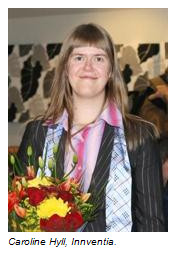Caroline Hyll presented her licentiate thesis “Infrared emittance of paper – method development, measurements and application” at Innventia. This work will enhance the use of thermography in the pulp and paper industry.
 Thermography is a non-destructive technique which uses the emitted infrared radiation to determine the surface temperature distribution of an object. The technique is increasingly used in the pulp and paper industry. To convert the detected infrared radiation to temperature, the emittance of the material must be known. The emittance is a radiative material property which may vary with wavelength, temperature, observation angle, moisture content, material composition, material structure, and surface roughness. An as exact as possible emittance value for a given measurement situation is therefore crucial for the accuracy of thermographic measurements.
Thermography is a non-destructive technique which uses the emitted infrared radiation to determine the surface temperature distribution of an object. The technique is increasingly used in the pulp and paper industry. To convert the detected infrared radiation to temperature, the emittance of the material must be known. The emittance is a radiative material property which may vary with wavelength, temperature, observation angle, moisture content, material composition, material structure, and surface roughness. An as exact as possible emittance value for a given measurement situation is therefore crucial for the accuracy of thermographic measurements.
The emittance of paper has not been studied for many of the conditions that are encountered in a paper mill. This general lack of information may partly be explained by limitations of existing emittance measurement methods. No emittance measurement method that allows for variation of temperature, observation angle and moisture ratio exist. Additionally, the emittance of paper may not be predicted by current analytical models. The limitations of existing models stress the importance of measuring the emittance.
The aim of this thesis is to improve the accuracy of thermographic measurements in the pulp and paper industry by providing emittance values for different materials under different process conditions. These values can also be used in future modelling of infrared emission from paper at different stages in the papermaking process.
Based on a thorough literature study providing state of the art knowledge, a new angle-resolved goniometric emittance measurement method suitable for paper samples exposed to different temperatures and moisture ratios was developed. Followed by verification testing and error analysis of the system, a large number of angle-resolved emittance measurements were made on paper and board in conditions similar to those at different stages in the papermaking process. The method was applied, and the applicability of measured emittance values to quantitative thermographic measurements was demonstrated.
“I hope that my work will be of use in the pulp and paper industry. Companies that want to use this technique should be able to find values and references applicable to their processes in the thesis,” says Caroline Hyll.
“Caroline’s thorough experimental studies and method development help us a lot when we perform thermographic measurements both in the laboratory and in paper mills,” says Hannes Vomhoff who has been Caroline’s supervisor at Innventia.
